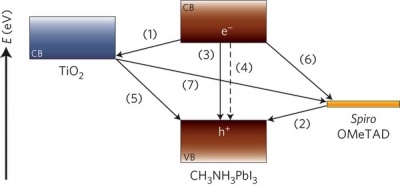Jacques Moser and co-workers: Photoinduced charge transfer processes in solar cells
January 19, 2014Unravelling the mechanism of photoinduced charge transfer processes in lead iodide perovskite solar cells
Lead halide perovskites have recently been used as light absorbers in hybrid organic–inorganic solid-state solar cells, with efficiencies as high as 15% and open-circuit voltages of 1 V. However, a detailed explanation of the mechanisms of operation within this photovoltaic system is still lacking. Here, we investigate the photoinduced charge transfer processes at the surface of the perovskite using time-resolved techniques. Transient laser spectroscopy and microwave photoconductivity measurements were applied to TiO2 and Al2O3 mesoporous films impregnated with CH3NH3PbI3 perovskite and the organic hole-transporting material spiro-OMeTAD. We show that primary charge separation occurs at both junctions, with TiO2 and the hole-transporting material, simultaneously, with ultrafast electron and hole injection taking place from the photoexcited perovskite over similar timescales. Charge recombination is shown to be significantly slower on TiO2 than on Al2O3 films.
Marchioro, A., Teuscher, J., Friedrich, D., Kunst, M., van de Krol, R., Moehl, T., Grätzel, M.l., and Moser, J.-E. (2014) Unravelling the mechanism of photoinduced charge transfer processes in lead iodide perovskite solar cells. Nat. Photon. 8, 250-255, (10.1038/nphoton.2013.374).
The paper was discussed on a series of websites:
- EurekAlert! “Understanding the functioning of a new type of solar cell”
- Phys.org “Scientists unravel the mechanism of the functioning of a new type of solar cell”
- Science Daily “Understanding the functioning of a new type of solar cell”
- R&D “Understanding perovskite-based solar cells”
- The Engineer “Insight into perovskites increases solar cell potential”
- pro-physik.de “Kurzer Prozess”
- Science World Report “Understanding the function of a new type of solar cell”
- EPFL “Le fonctionnement d'un nouveau type de cellules solaires élucidé”
- EPFL “Understanding the function of a new type of solar cell”
- EPFL “Towards a new type of solar cell”
- Goodnight Earth “New solar cell architecture provides efficiency competitive with thin film photovoltaics”
- DailyFusion “Scientists uncover charge transfer mechanism in perovskite solar cells”
- Press-News.org “Understanding the functioning of a new type of solar cell”
- Enerzine.com “Le fonctionnement d'un nouveau type de cellules solaires élucidé”

Figure 1: Schematic diagram of energy levels and electron transfer processes in an HTM|perovskite|TiO2 cell.

Figure 2: Time evolution of electron and hole populations in photoexcited CH3NH3PbI3 perovskite in various systems.
back <<

 Ursula Keller wins “Swiss Nobel” Marcel Benoist Prize
Ursula Keller wins “Swiss Nobel” Marcel Benoist Prize Farewell: the NCCR MUST ended
Farewell: the NCCR MUST ended  MUST2022 Conference
MUST2022 Conference New scientific highlights
New scientific highlights FELs of Europe prize for Jeremy Rouxel
FELs of Europe prize for Jeremy Rouxel Ruth Signorell wins Doron prize
Ruth Signorell wins Doron prize New FAST-Fellow Uwe Thumm at ETH
New FAST-Fellow Uwe Thumm at ETH International Day of Women and Girls in Science
International Day of Women and Girls in Science New scientific highlight
New scientific highlight EU XFEL Young Scientist Award for Camila Bacellar,
EU XFEL Young Scientist Award for Camila Bacellar, Prizes for Giulia Mancini and Rebeca Gomez Castillo
Prizes for Giulia Mancini and Rebeca Gomez Castillo Nobel Prize in Chemistry awarded to RESOLV Member Benjamin List
Nobel Prize in Chemistry awarded to RESOLV Member Benjamin List Hans Jakob Wörner invited to give the „New Horizons Solvay Lectures”
Hans Jakob Wörner invited to give the „New Horizons Solvay Lectures”  Unusual keynote talk at an international scientific conference
Unusual keynote talk at an international scientific conference NCCR MUST at Scientifica 2021
NCCR MUST at Scientifica 2021